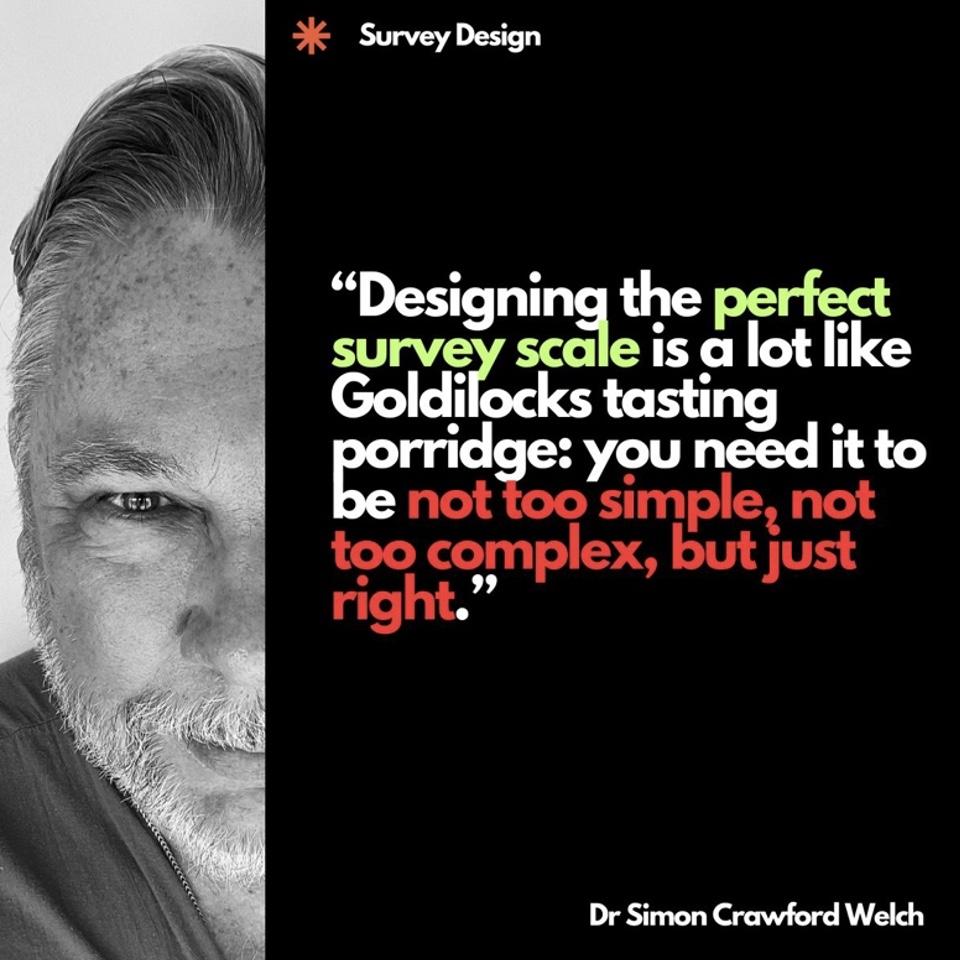By
Dr. Simon Crawford Welch
Founder, The Critical Thought Lab
www.linkedin.com/in/simoncrawfordwelch
Author of
“American Chasms: Essays on the Divided States of America” (Available on Amazon)

Designing a survey might sound simple: write some questions, send them out, and wait for responses. But anyone who’s ever tried knows it’s much more complicated. One of the trickiest parts? Choosing the right type of scale for your survey. Scales—those little tools that help respondents communicate their opinions, preferences, or experiences—can make or break your data. Pick the wrong one, and you could end up with information that’s not helpful or, worse, misleading.
Here’s a look at the most common types of survey scales, what they’re good for, and where they can trip you up. Whether you’re crafting an employee satisfaction survey, measuring customer feedback, or trying to get to the bottom of which pizza topping is most universally loved, this guide has you covered.
- Likert Scales: The Classic Crowd-Pleaser
You’ve definitely seen these before:
How satisfied are you with your experience?
1 = Not at all satisfied
2 = Slightly satisfied
3 = Neutral
4 = Satisfied
5 = Very satisfied
This is a Likert scale, the go-to for measuring attitudes, opinions, and feelings. It’s simple, versatile, and widely recognized, which means respondents usually know how to use it.
Pros
- Easy to Use: Likert scales are intuitive. Whether it’s a 5-point or 7-point scale, people can quickly grasp what they’re being asked.
- Balances Detail and Simplicity: A 5-point scale offers enough detail to capture trends without overwhelming the respondent.
- Great for Statistical Analysis: Likert scales generate numeric data, which is perfect for averages, correlations, and other statistical deep dives.
Cons
- Neutral Responses: That middle “neutral” option can be a double-edged sword. While it’s great for those truly in the middle, it also becomes an easy out for indecisive respondents.
- Cultural Bias: People from some cultures are more likely to avoid extreme responses, skewing your results toward the middle.
- Overuse: Because they’re so common, Likert scales can feel boring or repetitive.
- Semantic Differential Scales: The Polar Opposite Approach
Instead of asking how much someone agrees or disagrees, semantic differential scales provide two opposing adjectives:
The service was:
Friendly __ __ __ __ __ Unfriendly
These scales work well when you want to measure perceptions or attitudes on a spectrum.
Pros
- Rich Insights: By forcing respondents to pick a position on a spectrum, you eliminate the safe, middle-ground option.
- Flexible: These scales can measure almost anything—quality, satisfaction, attitudes, and more.
- Quick to Read: People instinctively know how to pick a spot between two extremes.
Cons
- Subjectivity: What “friendly” means to one person might not mean the same to someone else.
- Design Challenges: Crafting pairs of opposing terms that make sense can be harder than it looks. For example, is “informative” really the opposite of “confusing”?
- Analysis Complexity: Turning this data into meaningful numbers can take extra effort compared to a straightforward Likert scale.
- Binary Scales: Yes or No, Black or White
Binary scales are the simplest of all: yes/no, agree/disagree, true/false. They’re the survey equivalent of asking someone to pick a side.
Pros
- Simplicity: Everyone knows how to answer a yes/no question.
- Quick Completion: These questions are fast to answer, making them great for surveys where brevity matters.
- Clear Results: There’s no ambiguity—you either have agreement or disagreement.
Cons
- Lack of Nuance: Complex opinions can’t be captured in a binary format. For example, “Do you like your job? Yes or No” doesn’t tell you why.
- Forces a Decision: Some respondents might feel their true opinion isn’t represented by a binary choice.
- Rating Scales: Stars, Sliders, and More
You’ve seen this on product reviews or restaurant feedback forms:
Rate your experience from 1 to 10.
Or:
Drag the slider to indicate your satisfaction level.
These are rating scales, and they’re perfect for capturing preferences or satisfaction levels at a glance.
Pros
- Versatility: Rating scales can be adapted to a variety of formats, like numbers, stars, or sliders.
- Broad Spectrum: A 10-point scale provides more granularity than a 5-point Likert scale.
- Engaging: Interactive options like sliders can make surveys feel less monotonous.
Cons
- Subjective Interpretation: One person’s “7” might be another person’s “9,” even if they feel the same way.
- Overwhelming Choices: Scales with too many points (e.g., 1–100) can confuse respondents and reduce reliability.
- Design Limitations: Sliders and other visual scales might not work well on mobile devices or with older audiences.
- Ranking Scales: Put Them in Order
Ranking scales ask respondents to order options based on preference or importance:
Rank these in order of importance to you:
- Price
- Quality
- Convenience
This scale is great for understanding priorities.
Pros
- Prioritization: You can quickly identify what matters most to respondents.
- Useful for Decision-Making: Want to know if price beats quality? Rankings will tell you.
- Engaging Format: Ranking items can feel more interactive than simple ratings.
Cons
- Cognitive Load: Asking someone to rank five or more items can feel overwhelming.
- Ties Aren’t Allowed: Sometimes respondents feel two options are equally important, but ranking scales force them to choose.
- Data Analysis Challenges: Comparing rankings across respondents is more complex than analyzing simple ratings.
- Open-Ended Scales: Let Them Speak
Technically, these aren’t “scales” in the traditional sense, but they’re worth mentioning because they can complement other survey tools.
What did you like most about your experience?
[Open text box]
These questions allow respondents to explain their thoughts in their own words.
Pros
- Rich Insights: Open-ended responses can reveal nuances you’d never capture with predefined scales.
- Unbiased: There’s no prompting, so you get more authentic answers.
- Exploratory Potential: Perfect for identifying trends or themes you hadn’t considered.
Cons
- Time-Consuming for Respondents: Not everyone wants to write out a full response.
- Analysis is Tricky: Open-text responses require manual coding or advanced tools like text analysis software.
- Risk of Irrelevant Responses: Some people might go off-topic or leave the field blank altogether.
How to Choose the Right Scale
So, which scale should you use? It depends on your goals. Here are a few guiding questions to help you decide:
- What are you measuring?
- For attitudes or opinions, Likert scales or semantic differentials are often best.
- For priorities, go with ranking scales.
- For detailed feedback, include open-ended questions
- How detailed do you need the data to be?
- Use binary scales for quick, simple answers.
- Opt for rating or Likert scales for more nuanced insights.
- Who’s your audience?
- Keep it simple for audiences who might struggle with complex scales.
- Use interactive options like sliders for younger, tech-savvy respondents.
- What’s your analysis plan?
- If you need easy-to-analyze data, stick with Likert or rating scales.
- If you’re prepared for more advanced analysis, open-ended and ranking scales can provide richer insights.
Conclusion
Survey scales are the unsung heroes of data collection. They’re small but mighty, influencing how respondents interpret your questions and how useful your data will be. By understanding the pros and cons of each type, you can design surveys that not only get responses but also give you the insights you need to make informed decisions.
So, next time you’re designing a survey, take a moment to think about your scales. Your data – and your respondents – will thank you.
And please – do not try this at home! Professional design required.



